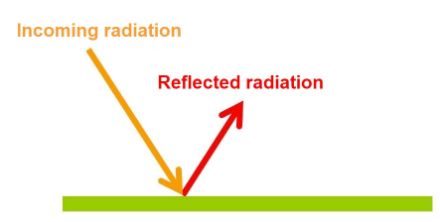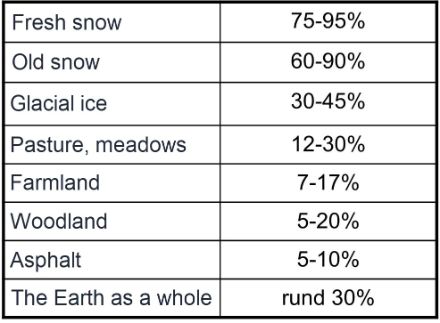Service Navigation
Search
Origin of the word
The word “albedo” comes from the Latin word “albus”, meaning white. So, literally translated, Albedo means “degree of whiteness”. This implies that the Albedo of a surface can more or less be “seen” based on its brightness. Our perception of it is approximate, because our eyes cannot see the entire shortwave spectrum.
What is Albedo?
Albedo is a measure of the proportion of radiation reflected by a surface. In other words, it describes the ratio of reflected radiation to incoming radiation:

The Albedo of a surface ranges from 0 to 1, or expressed as a percentage, between 0% and 100%. The higher the proportion of reflected radiation, the brighter the surface, and the higher the Albedo.

If 10% of the incoming radiation is reflected back from a surface, the Albedo of that surface is 10%. Light-coloured surfaces (in the visible spectrum) have a high Albedo, and dark ones a low Albedo. A surface that is covered with fresh snow can reflect up to 95% of the solar radiation, whereas most snow-free surfaces absorb a large proportion of the solar radiation.

Ice-Albedo feedback mechanism
The ice-Albedo feedback mechanism describes the interaction between the cryosphere (the areas of Earth that are covered by snow and ice) and the global climate. When ice melts due to global warming, this exposes more surfaces with water or vegetation. Ice has a high Albedo and reflects most of the solar radiation back into space, while water or vegetation absorb most of it. This means that the exposed surfaces absorb more solar energy, thus further warming them and leading to additional melting of snow and ice areas. This mechanism operates not only in polar regions but also in mountains, where glacier melting accelerates warming in a similar way. It is a positive feedback loop that amplifies the underlying cause. Conversely, cooling leads to an expansion of snow and ice areas, which increases the reflection of solar radiation and leads to further cooling.
Meteorology book by Hans Häckel